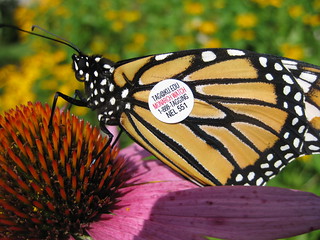Monarch butterflies are perhaps the most recognizable
butterflies to take wing in Vermont, but in recent years, there have been fewer
than ever before. The prolonged drought
in the southwest, harsh storms on the Monarchs’ wintering grounds, and overall
loss of habitat are all thought to be factors contributing to the Monarchs’
decline. Fortunately, 2012 has fared
better for Monarchs, and numbers are thought to be their highest in more than
five years.
Join NBNC every Wednesday afternoon through the end of September
as we catch Monarch butterflies and tag them, in an effort to track their
migration route. If we are lucky, a
Monarch we tag here at NBNC will be found in the mountains of central Mexico,
thousands of miles away. Each butterfly
we tag, if recovered, will offer an opportunity to learn more about how
Monarchs migrate and which paths they take on their journey. A better understanding of how they migrate
will allow us to better conserve these iconic butterflies for future generations.


No comments:
Post a Comment